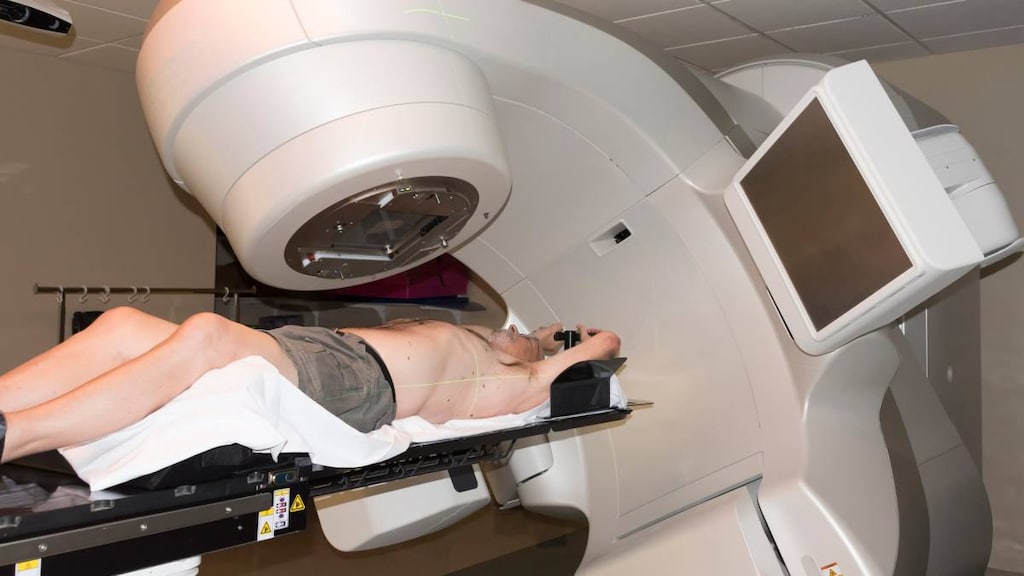The 4 stages of prostate cancer


Prostate cancer is a type of cancer that affects the prostate gland and begins when cells in the gland start to grow out of control.
There are four main stages of prostate cancer, which are used to describe the extent of a patient’s cancer - where it’s located and how much there is.
What is prostate cancer staging and why is it used?
Prostate cancer staging is a system used during the diagnosis process to determine the extent of a patient’s cancer. The stages of prostate cancer are used to describe the growth and spread of the cancer cells.
The four prostate cancer stages are used by healthcare professionals to:
- Classify the severity of the prostate cancer
- Provide a prognosis
- Determine the best course of treatment
- Enable researchers and healthcare providers to share patient information
Determining the stage of cancer may also necessary at other times. Cancer staging might also be done after drug therapy is used to shrink a tumor before surgery, for example. This is called post-neoadjuvant therapy staging. In addition to this, staging might also be done after treatment or if prostate cancer comes back.
How is the stage of prostate cancer determined?
A number of different tests are used to determine the stage of prostate cancer including:
- Screening tests including a:
- Digital rectal exam (DRE)
- Prostate-specific antigen (PSA) test
- Prostate biopsy - a core needle biopsy
- Imaging tests such as an:
- MRI (magnetic resonance imaging)
- CT scan (computerized tomography scan)
- TRUS (trans-rectal ultrasound)
A standardized staging system developed by the American Joint Committee on Cancer (AJCC) is the most commonly used staging system to help determine the stage of prostate cancer.
What is the AJCC TNM staging system?
The American Joint Committee on Cancer (AJCC) tumor-node-metastasis (TNM) staging system is a standardized system used as a reference by oncologists and other healthcare professionals to stage prostate and other cancers. The most recent update to this system occurred on January 1, 2018, when the 8th Edition of the staging system was implemented.
The TNM system uses 5 key factors to determine the stage of prostate cancer
1. T category
The T category measures the size and extent of the main or primary tumor.
The T category further classifies the prostate cancer into two different types including:
- Clinical category (cT), which is determined by your healthcare professional based on the results of a DRE, biopsy and imaging tests
- Pathologic category (pT), which is determined in a lab using a sample of your tumor collected during surgery. pT is generally a more accurate estimate than cT
2. N category
The N category measures whether cancer has spread to nearby lymph nodes.
3. M Category
The M category indicates whether cancer has metastasized or spread to other organs in the body
4. PSA levels
A blood test is taken to measure PSA levels. A high blood PSA level may indicate prostate cancer.
5. Grade Group or Gleason Score
The Grade Group measures the likelihood of the cancer growing and spreading (metastasizing) and is based on the Gleason Score.
The Gleason score involves looking at the cancer tissue and assigning it a grade depending how much it looks like normal prostate tissue.
Grade 1 looks like normal prostate tissue, while grade 5 is assigned to very abnormal looking tissue. Grades 2-4 are used for everything else in between. Most cancers are grade 3-5.
Tumors can have areas of different grades, so the two areas making up the bulk of the tumor are graded separately and their scores added together in a Gleason sum. The first number in the sum is assigned to the grade that is most commonly found in the tumor. For example, if a tumor is predominantly made up of grade 4 tissue with a smaller area of grade 5 tissue, then it would have a Gleason score of 4+5=9.
A Gleason score of:
- Less than or equal to 6 indicates the tumor is a well-differentiated or low grade tumor
- 7 indicates the tumor is a moderately-differentiated or intermediate grade tumor
- 8-10 indicates the tumor is a poorly differentiated or high grade tumor
Grade Groups have been developed to overcome some of the limitations of the Gleason Score system.
- Grade Group 1 = Gleason less than or equal to 6
- Grade Group 2 = Gleason 3+4=7
- Grade Group 3 = Gleason 4+3=7
- Grade Group 4 = Gleason 8
- Grade Group 5 = Gleason 9-10
Once the results of the T, N and M categories are known stage grouping occurs, which involves combining these results with the PSA level and Grade Group results to determine the overall stage of the prostate cancer. There are four main stages of prostate cancer.
What are the 4 stages of prostate cancer?
The four stages of prostate cancer range from stage 1 (I) through to stage 4 (IV). Stages are further split by letters. The higher the prostate cancer stage number, the more advanced the cancer is.
Stage
|
Tumor felt during DRE
|
Tumor seen during imagining
|
Amount of prostate
|
Tumor detected
|
Disease in nearby lymph nodes(YN) |
Metastatic spread to distant sites(Y/N) |
PSA level |
Stage 1 |
|||||||
| 1 GG 1 GS ≤ 6 |
N | N | Y (cT1) | N (N0) | N (M0) | <10 | |
| 1 GG 1 GS ≤ 6 |
Y | Y | In half or less of one side of the prostate (cT2a) | N | N | <10 | |
| 1 GG 1 GS ≤ 6 |
Tumor only in prostate | Y (pT2) | N | N | <10 | ||
Stage 2 |
|||||||
|
2A OR |
N | N | Y (cT1) | N | N | ≥10 - <20 | |
|
2A OR |
Y | Y | Tumor in half or less of one side of prostate or if detected during surgery is only in the prostate (cT2a) | Y (pT2) /N | N | N | ≥10 - <20 |
| 2A GG 1 GS ≤ 6 |
Y | Y | Tumor in more than half of one side of prostate (cT2b) or both sides of prostate (cT2c) | N | N | ≥10 - <20 | |
| 2B GG 2 GS 3+4=7 |
Y/N | Y/N (T1 or T2) | N | N | <20 | ||
| 2C GG 3 or 4 GS 4+3=7 |
Y/N | Y/N (T1 or T2) | N | N | <20 | ||
Stage 3 |
|||||||
| 3A GG 1-4 GS ≤8 |
Y/N | Y/N (T1 or T2) | N | N | ≥20 | ||
| 3B GG 1-4 GS ≤8 |
Tumor affects prostate and may have spread to the seminal vesicles (T3) or adjacent sites in the pelvis (local spread) (T4) | N | N | Any | |||
| 3C GG 5 GS 9-10 |
Tumor affects the prostate and may or may not have spread to adjacent sites (local spread) (and T) | N | N | Any | |||
Stage 4 |
|||||||
| 4A GG 1-5 |
Tumor affects the prostate and may or may not have spread to adjacent sites (local spread) (any T) | Y (N1) | N | Any | |||
| 4B GG 1-5 |
Tumor affects the prostate and may or may not have spread to adjacent sites (local spread) (any T) | Y/N (any N) | Y (M1) | Any |
The Prostate Cancer Research Institute uses colors to describe the stages
The Prostate Cancer Research Institute (PCRI), which is dedicated to helping educate patients and caregivers about prostate cancer, has developed a staging system using colors.
Unlike the other staging systems designed for healthcare professionals making treatment decisions, such as the AJCC TNM system, this one is a simplified system targeted at patients. It’s designed to help educate men with prostate cancer so that they have a better understanding of their disease, enabling for improved communication with their healthcare provider.
The PCRI system involves taking a six question quiz, using information from your medical records, to determine the likely stage of prostate cancer you have. Knowing more about your stage of prostate cancer is intended to put you in a better position to start the conversation about treatment options with your healthcare professional.
This PCRI prostate cancer staging system has five stages as follows:
- Sky - A low-risk stage that requires active surveillance
- Teal - An intermediate-risk stage with three sub-levels - low, basic and high
- Azure - A high-risk stage
- Indigo - A stage covering men with relapsed disease with three sub-levels - low, basic and high
- Royal - An advanced stage of disease where the prostate cancer has spread outside of the pelvic lymph nodes or developed resistance to certain medications. This stage also has three sub-levels - low, basic and high
More about the prostate
The prostate gland sits below the bladder and surrounds part of the urethra - the tube that carries urine from the bladder to the penis.
The prostate gland is only found in males and it produces a fluid that mixes with sperm to make semen (seminal fluid). Seminal fluid helps sperm to travel and survive and it is stored in the seminal vesicles that sit on top of the prostate gland. Seminal fluid helps sperm to be carried out of a man’s body during orgasm.
The prostate gland also produces prostate-specific antigen (PSA), a protein that helps to make semen more watery.
In younger men the prostate gland is about the size of a walnut, but it can grow larger as a man ages.
Article references
- American Cancer Society (ACS). What Is Prostate Cancer? Available at: https://www.cancer.org/cancer/prostate-cancer/about/what-is-prostate-cancer.html. August 1, 2019. [Accessed June 9, 2021].
- Macmillan Cancer Support. The Prostate. January 31, 2021. Available at: https://www.macmillan.org.uk/cancer-information-and-support/prostate-cancer/the-prostate. [Accessed June 9, 2021].
- Loma Linda University - Proton Therapy Treatment Center. Diagnosis of Prostate Cancer. Available at: https://protons.com/proton-treatments/prostate-cancer/diagnosis-prostate-cancer. [Accessed June 9, 2021].
- American Cancer Society (ACS). Tests to Diagnose and Stage Prostate Cancer. May 27, 2021. Available at: https://www.cancer.org/cancer/prostate-cancer/detection-diagnosis-staging/how-diagnosed.html. [Accessed June 9, 2021].
- Amin MB, Edge S, Greene F, et al. (2017) AJCC Cancer Staging Manual. Eight Edition. Springer International Publishing. Available at: https://www.springer.com/gp/book/9783319406176.
- Buyyounouski MK, Choyke PL, McKenney JK, et al. Prostate cancer - major changes in the American Joint Committee on Cancer eighth edition cancer staging manual. CA Cancer J Clin. 2017;67(3):245-253. doi:10.3322/caac.21391.
- American Cancer Society (ACS). Prostate Cancer Stages and Other Ways to Assess Risk. August 1, 2019. Available at: https://www.cancer.org/cancer/prostate-cancer/detection-diagnosis-staging/staging.html. [Accessed June 9, 2021].
- Cancer Treatment Centers of America. Prostate cancer stages. May 24, 2021. Available at: https://www.cancercenter.com/cancer-types/prostate-cancer/stages. [Accessed June 9, 2021].
- Prostate Cancer Research Institute. Video: The Five Stages of Prostate Cancer. September 12, 2018. Available at: https://pcri.org/insights-blog/2018/9/12/video-the-five-stages-of-prostate-cancer-the-prostate-cancer-video-series. [Accessed June 9, 2021].
- Cancer Research UK. TNM Staging. July 15, 2019. Available at: https://www.cancerresearchuk.org/about-cancer/prostate-cancer/stages/tnm-staging. [Accessed June 9, 2021].
- Prostate Cancer Foundation. Prostate Cancer Staging. Available at: https://www.pcf.org/about-prostate-cancer/diagnosis-staging-prostate-cancer/prostate-cancer-staging/. [Accessed June 9, 2021].
- Cancer.Net. Prostate Cancer: Stages and Grades. September 2020. Available at: https://www.cancer.net/cancer-types/prostate-cancer/stages-and-grades. [Accessed June 9, 2021].
- American Cancer Society (ACS). Cancer Staging. June 18, 2020. Available at: https://www.cancer.org/treatment/understanding-your-diagnosis/staging.html. [Accessed June 9, 2021].




